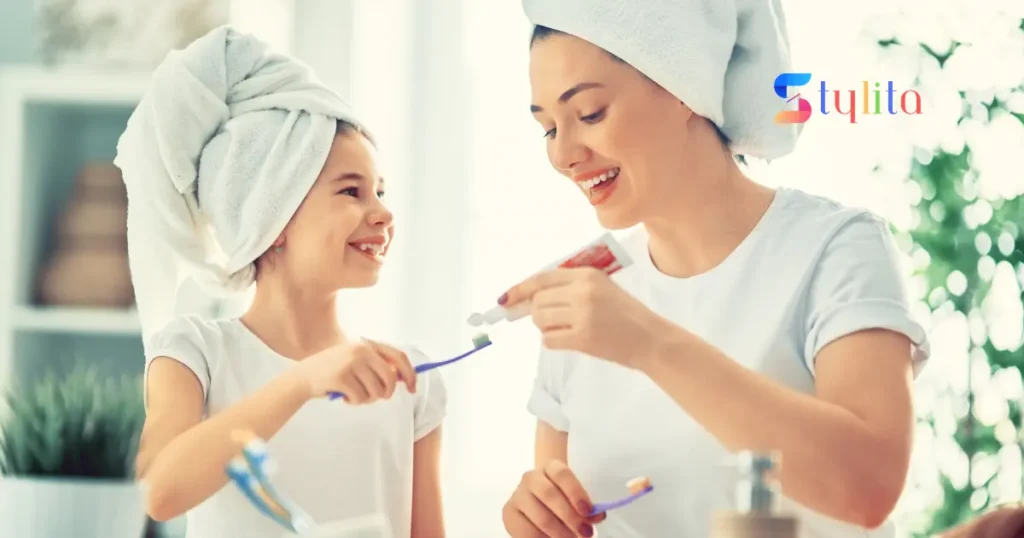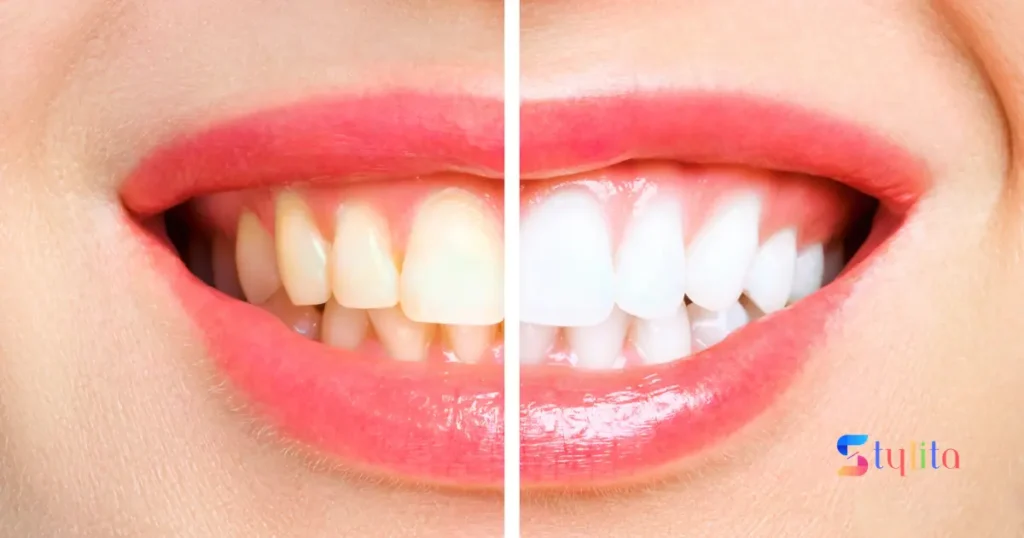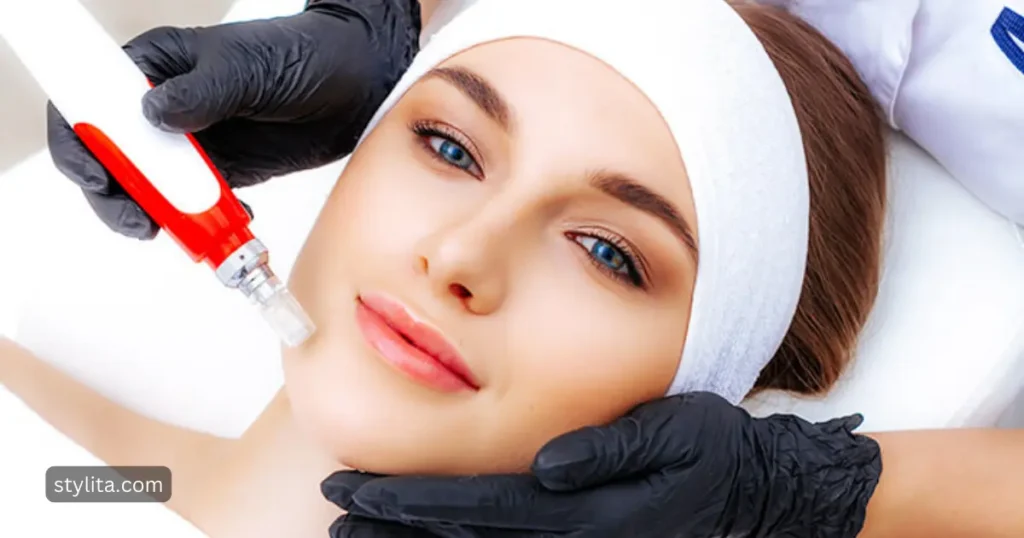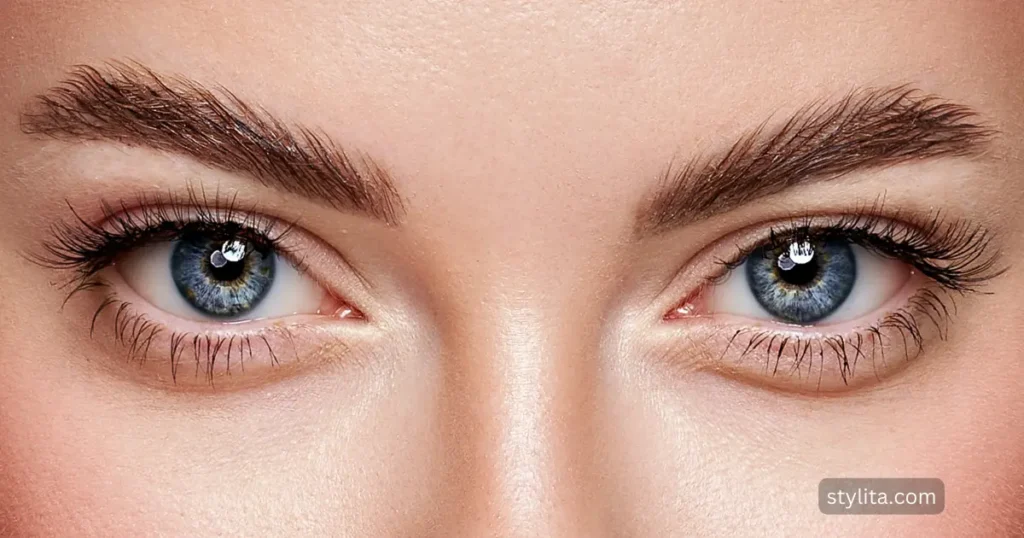If you’re interested in achieving a brighter smile then you should try a few remedies that could potentially assist you in achieving your goal. You must be vigilant while using at-home whitening products to prevent any potential harm to your teeth or the removal of enamel. It’s important to be aware of the potential risks of sensitivity and cavities.
As we grow older, it’ is common for our teeth to lose their bright, pearly-white appearance and take on a more yellow or darker shade. As the outer enamel gradually wears down, the underlying dentin starts to become more noticeable, taking on a yellowish hue. Dentin is a crucial layer of calcified tissue that lies just beneath the outer enamel layer. It plays a vital role in maintaining the overall health and structure of our teeth. Without dentin, our teeth would be much more vulnerable to damage and decay.
Tips to Brighten Your Smile

If you’re looking to brighten up your smile, there are several natural remedies you can try. Following seven options can help you get rid of those yellow stains on your teeth. Give them a go and see which one works best for you!
Opting for a handful of treatments and alternating them throughout the week could be a wise approach. Although not all of the following recommendations have research backing, anecdotal evidence suggests that they are effective.
1. Brushing Your Teeth
Brushing your teeth is an essential part of maintaining good oral hygiene. It helps to keep your teeth clean and free from plaque. It also freshens your breath and promotes overall dental health. By brushing your teeth at least twice a day, you can effectively remove food particles and bacteria that can lead to tooth decay and gum disease. Remember to use a soft-bristled tooth brush. Brushing your teeth regularly is crucial, especially after consuming certain foods and drinks that have the potential to cause yellowing.

It’s important to exercise caution when brushing your teeth right after consuming acidic foods and drinks. Brushing immediately can cause the acids to remove more enamel, resulting in erosion.
It is important to maintain good oral hygiene by brushing your teeth at least twice a day for 2 minutes each time. It’s important to thoroughly clean every nook and cranny. For optimal gum protection, it’s important to brush your teeth in a gentle, circular motion. Make sure to thoroughly brush all areas of your teeth, including the inside, outside, and chewing surfaces.
Did you know that using a whitening toothpaste can actually help brighten your smile? It’s true! In fact, a recent study found scientific evidence to support this claim. So, if you’re looking to achieve a whiter smile, incorporating a whitening toothpaste into your oral care routine might be worth considering. Whitening toothpastes are designed to effectively eliminate surface stains from your teeth while ensuring a safe and gentle experience. They achieve this through the use of mild abrasives that delicately scrub away any discoloration.
Did you know that using an electric toothbrush can actually be more effective at removing those pesky surface stains? It’s true! Not only does it provide a deeper clean, but it also helps to remove plaque and tartar buildup. So, if you’re looking to achieve a brighter, whiter smile, consider switching to an electric toothbrush. Your teeth will thank you!
2. Baking Soda and Hydrogen Peroxide
Many people use a homemade paste made of baking soda and hydrogen peroxide. This powerful combination not only helps remove plaque but also targets bacteria. It leaves your teeth looking and feeling cleaner. It’s a natural solution that can give you the fresh, confident smile you’ve always wanted. Give it a try and see the difference for yourself!
Creating a paste is as simple as combining 1 tablespoon of baking soda with 2 tablespoons of hydrogen peroxide. Make sure to rinse your mouth completely with water after brushing using this paste. Another option is to use the same ratio of ingredients to create a homemade mouthwash. Alternatively, you could experiment with a mixture of baking soda and water.
According to a reliable source, individuals who incorporated toothpaste infused with baking soda and hydrogen peroxide into their oral care routine experienced significant improvements in tooth stain removal and teeth whitening. After just 6 weeks, they demonstrated remarkable progress.
3. Coconut Oil Pulling
Coconut oil pulling has gained popularity in recent years as a natural oral health practice. It involves swishing coconut oil in your mouth for a certain period of time, typically 10–20 minutes, and then spitting it out. Many people claim that this practice can improve oral hygiene, whiten teeth, and even promote overall health. While scientific evidence is limited, some studies suggest
Coconut oil pulling has been praised for its ability to effectively eliminate plaque and bacteria from the mouth, resulting in noticeably whiter teeth. But be mindful of avoiding any contact between the oil and the back of your throat. It is important to avoid ingesting the oil, as it may contain harmful toxins and bacteria from your mouth.
It’s important to dispose of it properly to avoid any potential drain clogs. You can either spit it into the toilet or use a wastepaper basket. It’s important to remember to rinse your mouth with water and follow it up with a refreshing glass of water. Make sure to brush your teeth regularly. While there is no concrete scientific evidence to support the teeth-whitening benefits of oil pulling, many people have reported positive results from this ancient practice.
4. Apple cider vinegar
Apple cider vinegar has gained popularity in recent years for its potential health benefits. Many people use it as a natural remedy for various ailments, including digestive issues and weight loss. It has a distinct sour flavor and potent aroma as a result of fermenting apple cider. Some studies suggest that apple cider vinegar may help lower blood sugar levels and improve insulin sensitivity. However, its usage in teeth whitening cannot be neglected.
Creating your own mouthwash is a breeze. Just combine 2 teaspoons of apple cider vinegar with 6 ounces of water and you’re good to go! Give the solution a good swish for about 30 seconds. Afterward, gently rinse your mouth with water and diligently brush your teeth.
In a study it was discovered that apple vinegar can actually have a surprising effect on the color of cow teeth. The researchers found that this natural ingredient has a bleaching effect, which could potentially be beneficial for dental care. This fascinating finding sheds light on the potential uses of apple vinegar beyond its culinary applications. It’s important to keep in mind that it can potentially harm the strength and surface of your teeth. It is important to exercise caution and limit usage to brief periods. Further research is required to build upon these findings and gain a deeper understanding.
5. Lemon, Orange or Banana Peels
There are individuals who believe in the power of using lemon, orange, or banana peels to achieve a brighter smile. Did you know that certain citrus fruit peels contain a compound called d-limonene and/or citric acid? It is believed that these compounds have the potential to whiten your teeth.
For a refreshing twist on oral hygiene, try gently massaging fruit peels against your teeth for approximately 2 minutes. It is important to remember to rinse your mouth thoroughly and brush your teeth after. There is a noticeable lack of scientific research supporting the effectiveness of using fruit peels to achieve whiter teeth.
Using a toothpaste that includes d-limonene and a whitening formula can make a noticeable difference in reducing smoking stains. However, it’s important to note that this toothpaste may not be as effective in removing long-standing smoking stains or tea stains. For best results, it’s recommended to brush with this toothpaste twice a day for 4 weeks. It is important to exercise caution when implementing this strategy due to the acidic nature of fruit. Your enamel is at risk of erosion and wearing away due to the acid. If you happen to observe an increase in tooth sensitivity, it is advisable to discontinue the use of this particular method.
6. Activated charcoal
Activated charcoal has gained significant popularity in recent years due to its numerous potential benefits. This black powder, derived from various sources such as coconut shells or wood, is known for its ability to adsorb toxins and chemicals. It is commonly used in emergency rooms to treat drug overdoses or poisonings. Activated charcoal is a fantastic option for effectively eliminating those pesky tooth stains. Charcoal has gained popularity as a potential solution for removing pigments and stains from teeth, thanks to its impressive absorbent properties. There are claims that it can eliminate bacteria and toxins from the mouth.
Did you know that some toothpastes now include activated charcoal as an ingredient, with the promise of achieving whiter teeth? It’s true! These innovative toothpastes have gained popularity in recent years as people seek out natural and effective ways to enhance their smiles. By harnessing the power of activated charcoal, these toothpastes aim to provide a gentle and safe whitening experience.
If you happen to have sensitive teeth or simply prefer a gentler approach, there’s a handy trick you can try. Instead of applying the charcoal directly, you can opt to dab it on your teeth. This way, you can still enjoy the benefits without any unnecessary discomfort. Allow it to sit for a duration of 2 minutes.
Another interesting way to utilize activated charcoal is by combining it with a small quantity of water to create a refreshing mouthwash. Gently swish this solution for a duration of 2 minutes, ensuring that it reaches all areas of your mouth, before expelling it. Make sure to rinse your mouth completely with water after using activated charcoal.
7. Eating Fruits and Vegetables with a Higher Water Content
There is a belief that incorporating raw fruits and vegetables with a high water content into your diet can contribute to maintaining optimal dental health. It is believed that the water content helps to purify your teeth and gums by removing plaque and bacteria, which are responsible for causing yellow teeth.
Did you know that munching on crisp fruits and veggies after a delicious meal can actually boost the production of saliva in your mouth? Regularly using this technique can effectively eliminate stubborn food particles lodged between your teeth and effectively neutralize any potentially harmful acids. Although it is widely believed that consuming a diet rich in fruits and vegetables is beneficial for both dental and overall health, the scientific evidence backing up these claims is somewhat limited. It’s worth noting that incorporating these nutritious foods into your daily diet is a great idea.
In a recent study, researchers explored the connection between high plasma vitamin C levels and maintaining healthy teeth. Although the study did not specifically examine the whitening effect of vitamin C on teeth. It shed light on the potential benefits of maintaining optimal vitamin C levels for dental health. According to recent research, it has been found that vitamin C can play a significant role in reducing plaque buildup, which is responsible for the unsightly yellowing of teeth.
What causes Yellow Teeth
Ever wondered why your teeth turn yellow? It’s a common concern that many people have. There are numerous causes of yellow teeth, ranging from certain medical conditions to lifestyle choices. One of the main culprits is poor oral hygiene. If you neglect to brush and floss regularly, plaque and tartar can build up on your teeth, leading to discoloration.
There are several factors that can contribute to the yellowing of teeth:
- certain foods or drinks, such as blueberries, red wine, coffee, or tea
- a diet high in sugar and simple carbohydrates
- smoking or chewing tobacco
- side effects of certain medications and mouthwashes
- age, as older adults are more likely to have yellow teeth
- genetics
- mouth trauma
- excessive fluoride consumption
- poor dental care and oral hygiene
- chronic dry mouth or lack of saliva
Conclusion
It’s important to exercise caution when it comes to your oral health, as improper care can result in enamel and gum damage. This can then lead to issues such as sensitivity and cavities. Achieving a dazzling smile requires a proactive approach. By taking preventive measures, maintaining a consistent oral care routine, and scheduling regular dental checkups, you can keep your teeth looking their best.



